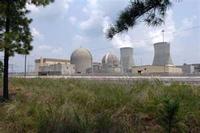-
New system could predict solar flares, give advance warning to help protect power grids

Researchers may have discovered a new method to predict solar flares more than a day before they occur, providing advance warning to help protect satellites, power grids, and astronauts from potentially dangerous radiation
-
-
Concerns about U.S. grid grow along with demand for power

The U.S. grid is stretched to capacity and severely outdated; some experts fear that blackouts in the past years in New York, Boston, and San Diego will become more frequent in the near future unless a multi-billion dollar overhaul is worked out
-
-
High temperature superconducting cables for electricity grids
Power grids around the world are reaching their limits at the same time that electricity demand is growing. European researchers developed and tested one of the first superconductor-based cables to address the issue; high temperature superconducting (HTS) cables have gained attention in the last couple years as a solution to the shortage of transmission capabilities
-
-
A 10-year plan for Europe’s grid
A new study shows that 104 billion euro over ten years need to be invested in the refurbishment or construction of roughly 52,000 km of extra high voltage power lines and cables across Europe in order to add 3 percent generation capacity and the reliable integration of 125 GW of renewable energy sources
-
-
Smart grid: from deployment to applications
Some 200 million smart meters have been deployed worldwide, forty million of them in North America; a new white paper from Pike Research says that the year 2012 represents a turning point for the sector
-
-
New material to improve efficiency of power grids
Global energy demand is on the rise, as populations continue to grow and industrialization progresses; at the same time, there is a growing awareness and concern about repercussions of increasing rates of carbon dioxide emissions released in the atmosphere; a new nanocomposite material holds the promise of enabling smarter, more reliable, and greener power systems
-
-
NRC approves first new nuke reactors since 1978

For the first time since 1978, U.S. nuclear regulators have approved the construction of a new nuclear power plant; the Nuclear Regulatory Commission (NRC) recently voted four-to-one in favor of granting Southern Co. a license to build two additional reactors at its Plant Vogtle nuclear facility near Augusta, Georgia
-
-
Critical flaws in SCADA give hackers edge
In an effort to improve critical cybersecurity flaws in industrial control systems, last week researchers released exploit modules that take advantage of security gaps in six major control systems, but in doing so, have made it easy for hackers to infiltrate these systems as none of them have been patched or taken offline
-
-
GAO: critical infrastructure operators need more coherent regulations
A recent Government Accountability Office (GAO) report found that the bulk of U.S. critical infrastructure is inadequately protected as operators lack a coherent set of guidelines
-
-
Connecticut examines ways to bolster electrical grid during disasters –
Following Tropical Storm Irene and the29 October nor’easter that left thousands of homes without power across the northeast, Connecticut is considering new regulations that could bolster the power grid and improve resiliency during natural disasters
-
-
Electrical grid needs cybersecurity oversight: study

In a recently released report, researchers from the Massachusetts Institute of Technology say that a single federal agency should be tasked with protecting the United States’ electrical grid from cyberattacks; the Obama administration has proposed that DHS assume responsibility for the grid, while Congress has submitted proposals for both the Department of Energy and the Federal Energy Regulatory Commission (FERC)
-
-
MIT report warns U.S. electrical grid vulnerable
A new report from the Massachusetts Institute of Technology warns that the U.S. electrical grid is vulnerable to cyberatacks; according to the report, the U.S. electrical grid’s cybersecurity vulnerabilities stem from weaknesses in processes, technology, as well as the actual physical environment
-
-
SCADA systems’ vulnerability key weakness in Smart Grid deployments
The discovery of the Stuxnet worm in 2010 shone a harsh light on the fragility of industrial control systems (ICS), such as supervisory control and data acquisition (SCADA) systems, and has created a new urgency among security vendors and utility managers alike; new research forecasts that investments in ICS security will total $4.1 billion during the years between 2011 and 2018
-
-
NERC CIP-compliant grid security reporting tool
NERC CIP Standard is a comprehensive framework of physical and cyber security best practices to safeguard the bulk power system for North America; Skybox Security shows NERC CIP-compliant grid security reporting tool
-
-
Electrical grids in state of “chaos,” report finds
A recent report warned that the world’s electrical grid is in a “state of near chaos,” leaving it vulnerable to a devastating cyberattack; the report, released by Pike Research, found that a simple $60 smart phone app could enable an attack on smart grids due to an aging infrastructure, a lack of standards, and inadequate spending
-
- All
- Regional
- Water
- Biometrics
- Borders/Immig
- Business
- Cybersecurity
- Detection
- Disasters
- Government
- Infrastructure
- International
- Public health
- Public Safety
- Communication interoperabillity
- Emergency services
- Emergency medical services
- Fire
- First response
- IEDs
- Law Enforcement
- Law Enforcement Technology
- Military technology
- Nonlethal weapons
- Nuclear weapons
- Personal protection equipment
- Police
- Notification /alert systems
- Situational awareness
- Weapons systems
- Sci-Tech
- Sector Reports
- Surveillance
- Transportation
Advertising & Marketing: advertise@newswirepubs.com
Editorial: editor@newswirepubs.com
General: info@newswirepubs.com
2010-2011 © News Wire Publications, LLC News Wire Publications, LLC
220 Old Country Road | Suite 200 | Mineola | New York | 11501
Permissions and Policies
Editorial: editor@newswirepubs.com
General: info@newswirepubs.com
2010-2011 © News Wire Publications, LLC News Wire Publications, LLC
220 Old Country Road | Suite 200 | Mineola | New York | 11501
Permissions and Policies
